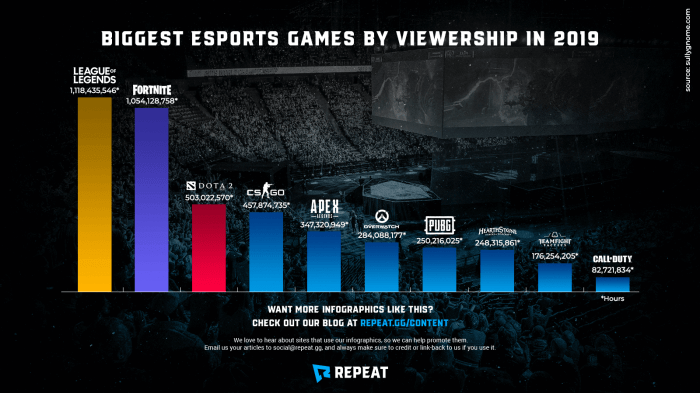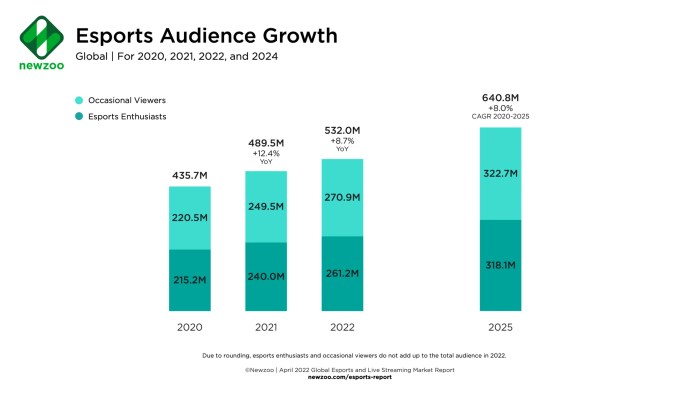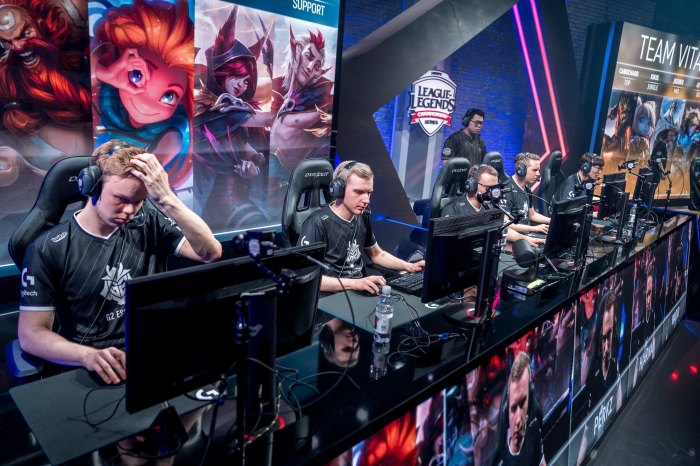Esports game analysis goes way beyond just watching the matches; it’s about dissecting the intricate strategies, player performances, and the ever-shifting meta that defines the competitive landscape. This deep dive explores everything from game mechanics and team dynamics to the business side of esports and the tech powering it all. We’ll be looking at how different games operate, the skills needed to succeed, and how the industry itself is evolving.
Think of it as a playbook for understanding the world of professional gaming. We’ll cover key performance indicators (KPIs) for individual players, analyze successful and unsuccessful team compositions, and even explore the impact of game patches on the competitive scene. We’ll also touch on the business side, including revenue streams and sponsorships, and peek into the future of esports.
Game Mechanics and Strategy: Esports Game Analysis

Esports thrives on the intricate interplay of game mechanics and strategic thinking. Understanding these core elements is crucial for appreciating the high-level play and the competitive landscape of professional gaming. This section will delve into the mechanics of three popular esports titles and then explore the strategic depth of one in more detail.
Core Mechanics Comparison: League of Legends, Dota 2, Counter-Strike
The following table compares the core mechanics of three prominent esports games, highlighting their key differences and similarities. These differences influence the strategic approaches players adopt.
| Game | Core Gameplay | Resource Management | Team Composition |
|---|---|---|---|
| League of Legends (LoL) | MOBA; lane-based combat, minion waves, objective control (towers, dragons, Baron Nashor) | Gold and experience; itemization crucial for character progression | Diverse roles (top, jungle, mid, ADC, support); synergy and counter-picking are vital |
| Dota 2 | MOBA; similar to LoL but with more complex mechanics and items; greater emphasis on individual skill | Gold and experience; itemization extremely nuanced and impactful | Similar roles to LoL, but with more flexibility and unique hero abilities |
| Counter-Strike: Global Offensive (CS:GO) | First-person shooter (FPS); objective-based rounds (bomb defusal/hostage rescue); emphasis on teamwork and map awareness | Economy management (buying weapons and equipment); crucial for round-to-round strategy | Roles (AWP, entry fragger, support) determined by weapon choices and playstyle; strong communication vital |
Strategic Depth in League of Legends: Decision-Making Under Pressure
League of Legends showcases exceptional strategic depth, demanding rapid decision-making under immense pressure. Professional players must constantly assess the game state, considering factors such as team composition, enemy itemization, map awareness, and objective control. A single poor decision, such as misjudging a teamfight or overextending, can easily snowball into a game-losing scenario. For example, choosing to engage in a teamfight when your team lacks crucial crowd control or healing spells can lead to a devastating defeat.
The ability to make these high-stakes choices swiftly and accurately separates amateur players from professionals. This often requires players to predict opponent behavior, anticipate their strategies, and adapt their own play accordingly.
Common Professional Strategies in League of Legends
Professional League of Legends teams employ sophisticated strategies, often adapting their approaches based on opponent teams and current meta. One common strategy is “early game aggression,” where a team focuses on securing early game advantages through ganks (ambushes) and objective control. This can involve prioritizing specific lanes or champions to gain an early lead in gold and experience.
Another frequent strategy is “late-game scaling,” where a team prioritizes team composition that excels in extended fights. This often requires sacrificing early game pressure for a stronger late-game presence. A third strategy involves focusing on specific objectives, like dragons or Baron Nashor, to gain significant advantages. Securing these objectives provides powerful buffs and often leads to victory.
The execution of these strategies requires impeccable coordination, precise timing, and flawless execution. Teams often develop unique strategies tailored to their specific roster’s strengths and weaknesses.
Meta Shifts and Patch Analysis

The competitive landscape of esports is in constant flux, shaped by both player ingenuity and developer interventions. Understanding these shifts, particularly those driven by patches, is crucial for analyzing team strategies and predicting future meta trends. This section will examine the evolution of the competitive meta in League of Legends over the past year, focusing on a specific patch and comparing contrasting meta strategies.
League of Legends Meta Shifts (2023-2024)
The following table Artikels significant meta shifts in League of Legends from October 2023 to October 2024. These shifts reflect both player adaptation and the impact of Riot Games’ patches.
| Date Range | Dominant Champions/Strategies | Key Factors | Notable Tournaments/Events |
|---|---|---|---|
| Oct 2023 – Dec 2023 | Early game aggressive junglers (Lee Sin, Graves), scaling ADCs (Aphelios, Zeri) | Strong early game pressure, emphasis on objective control. | Worlds 2023 Group Stage |
| Jan 2024 – Mar 2024 | Mid-game focused team compositions, scaling mages (Veigar, Viktor), tank meta emerging. | Patch 13.23 nerfs to aggressive junglers, rise of teamfight compositions. | LEC Spring Split |
| Apr 2024 – Jun 2024 | Sustained team compositions, scaling champions (Nasus, Sion), emphasis on late-game teamfights. | Patch 13.24 buffs to tank champions and late-game scaling. | MSI 2024 |
| Jul 2024 – Oct 2024 | Increased champion diversity, resurgence of assassin champions, flexible team compositions. | Patch 14.15 nerfs to tank items, buffs to mobility and assassin champions. | Worlds 2024 Play-ins |
Impact of Patch 13.24 on the Competitive Landscape
Patch 13.24 significantly altered the League of Legends meta by introducing substantial buffs to several tank champions and items. This shift directly impacted the competitive landscape, favoring team compositions prioritizing sustained damage and late-game teamfighting potential. Previously dominant early-game aggressive strategies became less effective, forcing teams to adapt to a slower, more deliberate style of play. The increased prevalence of tanks led to a more forgiving meta, reducing the impact of individual mistakes and emphasizing coordinated team play.
This was evidenced by a noticeable increase in the win rates of champions like Sion and Amumu, previously considered niche picks. The change also impacted draft strategies, with teams prioritizing tank champions and prioritizing team composition synergy over individual champion strength.
Comparison of Meta Strategies: Early Game Aggression vs. Late Game Scaling, Esports game analysis
The meta in League of Legends has historically swung between prioritizing early game aggression and late game scaling. Early game aggressive strategies, dominant in the pre-13.24 meta, emphasized securing early game objectives, snowballing leads, and ending games quickly. This involved champions with strong early game power spikes, such as Lee Sin and Graves, and a focus on securing dragons and Rift Herald.
Conversely, the late-game scaling meta, which emerged post-patch 13.24, focused on surviving the early game and leveraging the power of scaling champions like Nasus and Sion to dominate the late game. This approach involved prioritizing teamfight composition and securing strategic objectives like Baron Nashor to secure a late-game victory. The difference between these strategies highlights the fundamental trade-off in League of Legends between early game dominance and late-game power.
One strategy prioritizes quick victories while the other prioritizes outlasting the opponent.
Spectating and Commentary

Esports commentary isn’t just about describing the action; it’s about elevating the viewing experience, transforming a simple match into a captivating narrative. A great commentator provides context, analysis, and excitement, bridging the gap between the game’s mechanics and the audience’s understanding. This section dives into the key elements of effective esports commentary and how visual presentation enhances the spectator’s journey.Effective esports commentary hinges on a blend of technical expertise, engaging presentation, and insightful analysis.
The best commentators possess a deep understanding of the game’s mechanics, strategic nuances, and the current meta. Beyond technical proficiency, however, lies the art of storytelling. They weave a compelling narrative around the unfolding match, highlighting key moments, predicting outcomes, and connecting with the audience on an emotional level.
Elements of Effective Esports Commentary
An infographic illustrating effective esports commentary would feature several key elements, visually represented perhaps as interconnected nodes within a central circle labeled “Effective Commentary.” One node might be “Game Knowledge,” illustrated with icons representing game mechanics, strategies, and champion/character specifics. Another, “Narrative Skill,” could be shown as a speech bubble with a dynamic, engaging tone. “Audience Engagement” could be represented by happy viewer icons interacting with the broadcast.
Finally, “Technical Proficiency” might feature icons representing clear and concise speech, proper pronunciation, and a professional demeanor. These interconnected nodes emphasize the synergistic nature of these elements. A clear, concise, and engaging commentary style enhances the viewer’s understanding and overall enjoyment of the broadcast.
Visual Data Enhancement of Viewer Understanding
The presentation of visual data during esports broadcasts significantly improves viewer understanding by providing a contextual layer to the gameplay. For example, a mini-map overlay showing player positions and objectives allows viewers to grasp the strategic positioning and movement of teams. Real-time statistics, such as kill-death ratios, damage dealt, and objective control, provide quantifiable metrics to assess team performance and individual player contributions.
These visual aids translate complex in-game information into easily digestible formats, making the action more understandable and engaging for a broader audience. Consider the impact of a well-designed graph showing gold difference between teams over time in a MOBA game – it instantly tells a story of economic dominance or struggle.
Impact of Camera Angles and Replay Systems
Different camera angles and replay systems drastically alter the viewing experience. A wide-angle shot provides an overview of the battlefield, highlighting team positioning and overall strategic flow. Close-up shots, on the other hand, focus on individual player actions, allowing viewers to appreciate skillful maneuvers and clutch moments. Slow-motion replays with various angles, such as bird’s-eye view and player-perspective views, allow for detailed analysis of key moments, revealing subtle mechanics and strategic decisions that might have been missed during live gameplay.
For example, a slow-motion replay of a crucial team fight can highlight a single player’s perfectly timed ability use that turned the tide of the battle, revealing the nuance of high-level gameplay that otherwise might be missed. The skillful use of these tools enhances the viewing experience and offers different perspectives for a richer understanding of the game.
Esports Business and Economics

The esports industry isn’t just about flashy plays and intense competition; it’s a multi-million dollar business with complex revenue streams and a rapidly evolving economic landscape. Understanding the financial underpinnings of professional esports is crucial to grasping its overall growth and sustainability. This section delves into the key economic drivers and factors influencing the industry’s profitability and player valuation.
Esports Team Revenue Streams
Professional esports teams generate revenue through a variety of channels, each contributing to their overall financial health and competitive edge. The following table Artikels some of the most significant revenue streams:
| Revenue Stream | Description | Example | Potential Impact |
|---|---|---|---|
| Sponsorships & Brand Partnerships | Agreements with companies to promote their products or services. | A gaming peripheral company sponsoring a team’s jerseys and online content. | Significant revenue, brand exposure for both parties. |
| Prize Money | Earnings from winning tournaments and competitions. | Winning a major championship with a $1 million prize pool. | Highly variable, but can be substantial for top teams. |
| Merchandise Sales | Selling team-branded merchandise like apparel, accessories, and collectibles. | Selling team jerseys and hats through an online store. | Consistent revenue stream, builds fan loyalty. |
| Media Rights & Streaming Revenue | Revenue generated from broadcasting matches and content. | Sharing revenue from streaming platforms like Twitch or YouTube. | Growing revenue stream, dependent on viewership and contracts. |
The Role of Sponsorships and Brand Partnerships
Sponsorships and brand partnerships are arguably the lifeblood of many esports organizations. They provide a crucial influx of capital, allowing teams to invest in better facilities, player salaries, coaching staff, and other resources necessary for sustained success. For brands, esports offers a unique opportunity to reach a highly engaged and digitally native audience, often younger than traditional sports fans.
Successful partnerships often involve integrated marketing campaigns, including jersey sponsorships, in-game advertising, social media promotions, and co-branded content. For example, a partnership between a gaming headset manufacturer and a top esports team could involve the team using the headsets during competitions, featuring the brand prominently in their online streams, and creating joint promotional videos. This multifaceted approach maximizes brand visibility and resonates with the target demographic.
Factors Influencing the Market Value of Professional Esports Players
The market value of a professional esports player is influenced by a complex interplay of factors, much like traditional sports. Skill and performance are naturally paramount; consistent high-level gameplay, tournament victories, and individual accolades significantly boost a player’s value. However, other factors also play a crucial role. A player’s popularity and brand recognition, measured by social media following, streaming viewership, and overall fan engagement, are significant.
Players with a large and loyal fanbase are more attractive to sponsors and organizations, increasing their market value. The player’s age and potential for future growth also matter; younger players with high potential command higher valuations due to their longer career prospects. Finally, the specific game a player competes in, and the overall popularity and financial stability of that game’s esports scene, directly influence their market value.
A player excelling in a highly popular and lucrative game like League of Legends or Dota 2 will naturally command a higher price than a player in a less established esports title.
FAQ Resource
What’s the difference between a meta and a patch?
A meta is the dominant strategies and player choices within a game at a given time. A patch is a game update that often changes the meta by introducing new features, balancing changes, or bug fixes.
How important is mental fortitude in esports?
Mental fortitude is crucial. Esports players face intense pressure, and maintaining focus, composure, and resilience under stress is key to consistent high performance.
What role does streaming play in esports?
Streaming is huge! It allows for massive viewership, generates revenue through subscriptions and ads, and builds player and team brands.
Are esports players considered athletes?
Many argue yes! Esports requires intense physical and mental training, strategic thinking, and peak performance, much like traditional sports.